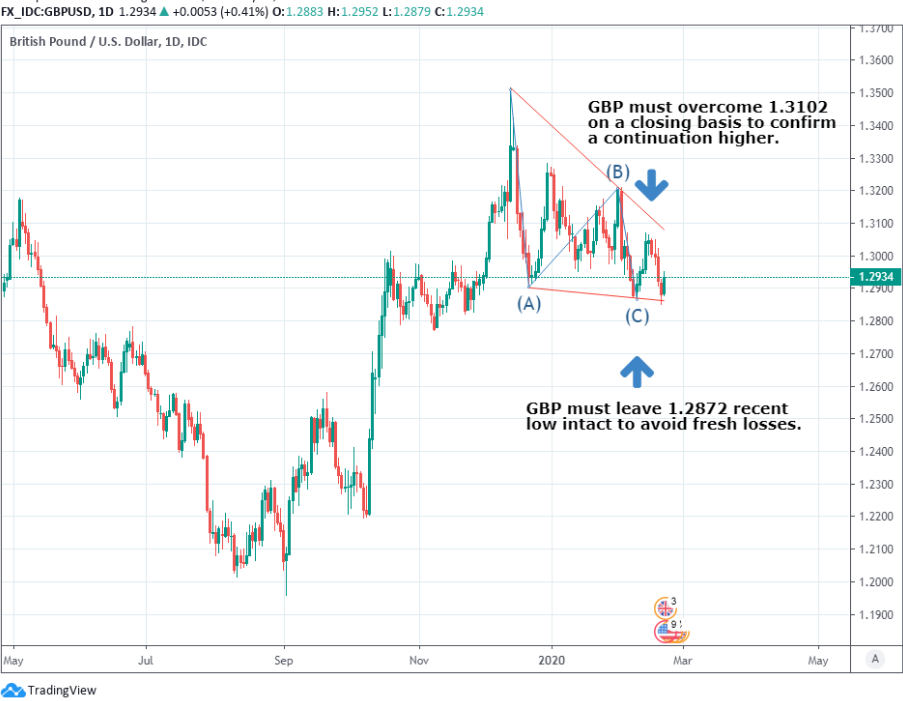The Pound-to-Dollar Rate Outlook is Still to Play For after Near Miss on Charts
- Written by: James Skinner
-
- GBP/USD saved from bearish technical development on charts.
- GBP/USD technical outlook has turned neutral, is still to play for.
- But USD's exceptionalist credentials burnished again by U.S. data.
- As coronavirus escapes China, burnishes safe-haven USD appeal.
- Overvalued and overbought USD can still outperform says MUFG.

Image © Adobe Images
- GBP/USD Spot rate: 1.2927, up +0.37% today
- Indicative bank rates for transfers: 1.2576-1.2667
- Transfer specialist indicative rates: 1.2735-1.2813 >> Get your quote now
Pound Sterling came close to doubling over against the Dollar this week but was spared from further imminent declines ahead of Thursday's closing bell, meaning the outlook for the Pound-to-Dollar rate is still all to play for.
The Pound reclaimed the 1.29 handle in Friday trading after having climbed back above the 1.2872 threshold which, according to technical analysts, is key to preserving the post-summer uptrend in the Pound-to-Dollar rate.
Positive IHS Markit surveys of conditions in the manufacturing and services industries were key to the Friday rise in the Pound, although it had already recovered its footing ahead of Friday's European session.
"We have not closed below the 1.2872 low. For today we suspect a bounce higher, beyond that we are neutral," says Karen Jones, head of technical analysis for currencies, commodities and bonds at Commerzbank in an early morning research note. "We are back to not knowing if this is a top or not, having failed at the 55 day moving average at 1.3055 and the short term downtrend at 1.3075, the risk has shifted to the downside."
Above: Pound-to-Dollar rate shown at 4-hour intervals.
Sterling retreated from a strengthening Dollar from mid-week, taking it briefly below the 1.2872 level in Thursday trading and indicating that further losses could be just around the corner. But Jones says the "intraday Elliott wave" is implying the down-move has ended and the new low was "not confirmed" by the relative-strength-index, which typically indicates waining momentum.
The British currency has continued its retreat from post-election highs thus far in 2020, carving out a series of lower-lows on the charts amid repeated failures to gather any kind of sustained upward momentum. And those failures, combined with Friday's signals from the charts, have led Jones and the Commerzbank team to turn neutral in their short-term outlook for the Pound-to-Dollar rate.
"Only a close below 1.2872, the recent low would put the 55 week ma at 1.2800 and the 200 day moving average at 1.2691 back on the plate," Jones says. "Only above the downtrend [1.3075] would negate downside pressure for recovery to initially 1.3285 and the 2015-2020 resistance line at 1.3412."
Friday's price action comes as a series of economic figures stoke optimism in some parts of the market about the outlook for UK growth.
Above: Pound-to-Dollar rate shown at daily intervals.
Retail sales bounced by a strong 0.9% in January, official data revealed on Thursday, while Wednesday's data dump from the Office for National Statistics (ONS) showed inflation closing the gap between the consumer price index and the 2% target of the Bank of England (BoE).
Earlier data points and Friday's PMI releases could enable the BoE to leave Bank Rate unchanged throughout 2020, contrary to market expectations, which would be supportive of the Pound against many currencies.
However, the Pound-to-Dollar rate outlook is clouded by what many say is an increasingly compelling case for owning the U.S. Dollar, which has been burnished this week as it became increasingly clear the coronavirus has well and truly escaped China's borders.
"The pick-up in cases outside of China over the past week creates fresh uncertainty over the potential negative spillover impact from the corona virus-related disruption. In the FX market there has been one clear beneficiary so far the emergence of the coronavirus shock and that has been the US dollar," says Lee Hardman, a currency analyst at MUFG. "Current trends appear unlikely to reverse soon. At the same time the US dollar is also benefiting from the release of stronger cyclical US economic data."
Above: Pound-to-Dollar rate shown at daily intervals.
Hardman drew attention Friday to the Bloomberg Economic Surprise index that has risen to its highest level for two years thus far in 2020 following what was a strong performance from the world's largest economy heading into year-end. And all of this is further entrenching the Dollar's notable 1% interest rate advantage over the Pound, with no signs yet that the Federal Reserve (Fed) is becoming any more inclined toward further rate cuts.
Minutes of the January Federal Reserve (Fed) meeting showed on Wednesday the bank sticking to its well-worn script which dictates that a “material change” in the outlook for the domestic economy is necessary in order to force a change of its on-hold rate stance. And that relatively 'closed' domestic U.S. economy is thought to be more insulated from any global slowdown that might materialise as economic damage is exported from China to other parts of the world.
"It reinforces the relative appeal of the US dollar in the near-term especially when the outlook for growth outside of the US is darkening in response to the negative coronavirus shock. The impact so far on the US economy appears limited. The Philly Fed survey for February and Conference Board’s leading index for January became the latest US data releases to surprise to the upside yesterday," Hardman says. "Overall, the stars are currently aligned for the US dollar to continue outperforming even if it is becoming more overvalued and overbought in the process."
MUFG, the world's fifth largest lender, forecasts the Pound will end the current quarter around 1.3210 and remain close to that level through subsequent months, before rising to only 1.3370 in time for year-end. Such an outlook implies little if-any deviation from the range seen thus far in 2020.













